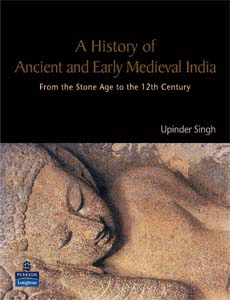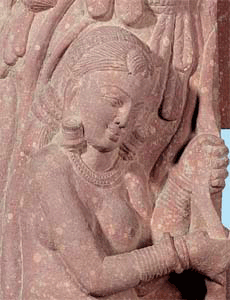Religions beyond ‘isms’
By Upinder Singh
 In the realms of religious doctrines and practices, the period c. 200 BCE to 300 CE reflects several continuities with the earlier centuries, but also some striking new developments.
In the realms of religious doctrines and practices, the period c. 200 BCE to 300 CE reflects several continuities with the earlier centuries, but also some striking new developments.
One of the most important of these was the beginning of new devotional practices within Buddhism and Jainism and the emergence of early Hinduism. New forms of worship were accompanied by new liturgies and mythologies. Religious teachers, saints, gods, and goddesses were worshipped or venerated in the form of images within the context of religious shrines.
The history of religions is usually constructed on the basis of frameworks provided by religious texts, which are not always accurately reflective of popular practice. Apart from their elite authorship and normative nature, some of them are difficult to date.
The beliefs and practices they mention often have earlier beginnings. Further, dominant religious traditions usually try to marginalize or ignore other traditions and therefore often give a distorted idea of their significance. An example is the case of the Ajivika sect, which, notwithstanding all the criticism of its ideas and leaders in Buddhist and Jaina texts, was clearly influential in many parts of the subcontinent across many centuries.
Further, religious texts do not always clearly reflect regional or local variations in practices, and there are some widely prevalent practices that they do not mention at all.
For all these reasons, although texts are extremely valuable sources for the history of religions, they have to be looked at along with evidence from archaeology, inscriptions, and coins.
When studying the history of different religions or sects separately, little attention is often paid to their contemporaneity and interaction. Studies of pilgrimage sites in India contain innumerable examples of places that are considered sacred for different reasons by different religious communities.
The interconnections and interactions between and among different religious traditions at the ground level also emerge clearly when we look at the archaeological evidence from specific sites, areas, and regions.
The sculptural motifs associated with ancient religious establishments reveal the existence of a shared pool of auspicious symbols. Their shrines reflect shared architectural styles that cut across sectarian differences. All this is not surprising, as these traditions and their adherents shared a common cultural space.
We will also see that there are several religious practices that were not specifically associated with a specific religious tradition but were an enduring feature of popular religion over many centuries. At the same time, the relationship between different religions or cults could also take the form of competition and conflict.
Yakshas, nagas, and goddesses

The worship of serpents—nagas and nagis (or naginis)—was another important aspect of religious worship that cut across religious boundaries. The nagas and nagis were associated with water and fertility. Like the yakshas and yakshis, they too were originally the focus of exclusive worship, but were in course of time absorbed into the dominant religions. Colossal naga figures belonging to the early centuries CE have been found in many places. Their imposing nature and the technical finesse of their carving make it amply clear that they do not represent a simple folk or village cult.
Female terracotta images have been found at various from prehistoric times onwards. Whether or not these had a cultic or religious significance involves subjective judgement.
The worship of goddesses during c. 200 BCE–300 CE is evident from archaeological evidence from many sites. Female figurines are sometimes associated with terracotta artefacts that are referred to in archaeological literature as votive tanks and shrines. These occur many sites in the subcontinent, from 3rd century BCE levels right up to medieval levels, showing that such objects were part of the paraphernalia of domestic rituals for over 1,000 years.
Puranic Hinduism
The English word ‘Hinduism’ is a fairly recent one and was first used by Raja Ram Mohun Roy in 1816–17. The word ‘Hindu’ is older and is derived from the Sindhu (Indus) river. It was originally a geographical term, used in ancient Persian inscriptions to refer to the lands beyond the Sindhu river. In the course of the medieval period, the term came to acquire a religious–cultural meaning. Modern-day Hinduism differs from other major world religions in many important respects, in that it has no founder, no fixed canon which embodies its major beliefs and practices, and no organized priesthood. It is also marked by a great variety in beliefs, practices, sects, and traditions. Some scholars argue that Hinduism is not so much a religion as a set of socio-cultural practices; others argue that it is inextricably linked to the existence of caste, and still others hold that we should talk of Hindu religions in the plural rather than the singular. The relative newness of the word, the problems of definition, and the existence of much internal diversity, are not sufficient reasons to avoid the use of the term Hinduism.
During the period c. 200 BCE–300 CE, there is evidence from a variety of sources of certain devotional practices that can be associated with Hinduism. This was the formative phase in the evolution of early Hindu pantheons. Some of the deities who became the foci of worship in this period are known from Vedic literature. However, during these centuries, they emerged as powerful supreme deities, whose images were installed and worshipped in temples and homes. The most influential of the newly emerging cults were associated with the worship of the gods Shiva and Vishnu and the goddess Durga.
The beginning of the theistic trends that came to the fore in this period can be traced to the later Upanishads. However, the process is more clearly visible in the Mahabharata and Ramayana. The new religiosity of devotion is also reflected in the Bhagavad Gita and the Puranas. Apart from textual sources, archaeological sites, sculptures, coins, and inscriptions give important data, which in some cases indicates earlier beginnings than suggested by texts.
The earliest inscriptional references to and archaeological remains of Hindu temples belong to c. 200 BCE–300 CE. Reference was made earlier to the Besnagar pillar inscription of Heliodorus, which records the installation of a pillar associated with a Vishnu templeand the remains of the foundations of a temple nearby. A 2nd century Nagari inscription mentions a temple of Samkarshana and Vasudeva. The remains of a temple dedicated to the Matrikas (the Seven Mothers) at Sonkh, a Lakshmi temple at Atranjikhera, a Shaiva temple at Gudimallam, and temples dedicated to Vishnu and Shiva at Nagarjunakonda can be considered to be among the earliest vestiges of Hindu temples in the subcontinent.
Although the period c. 200 BCE–300 CE witnessed the development of sectarian cults that considered a particular god or goddess as a supreme deity, there was also a parallel process which visualized the Hindu gods as closely related and performing complementary functions. This is evident, for instance, in the idea of the triad of Brahma, Vishnu, and Shiva, present in the Mahabharata and more clearly developed in the Puranas. In this triad, Brahma is associated with the creation of the world, Vishnu with its preservation, and Shiva its destruction. The three gods are also associated with different principles, from which arises their division of labour—Brahma is associated with rajas (the creative, active principle), Vishnu with sattva (the unattached, passive principle), and Shiva with tamas (the dark, fierce principle). In some places in the Puranas, the gods operate in their respective spheres according to this division of labour, in others they are described as manifestations of the same divine being.
The acknowledgement of other gods and their being considered worthy of respect is also evident from the fact that shrines dedicated to one deity often have sculptural representations of other deities as well. Polytheism simply refers to a belief in many gods, but monolatory means the belief in a supreme god without denying the existence of other gods. It is the latter term that best describes emergent Hinduism.
Extracted with permission from A History of Ancient and Early Medieval India: from the Stone Age to the 12th century by Upinder Singh. Pearson Longman. Pages 704.
– Discover the book : A History of Ancient and Early Medieval India
– Source : www.tribuneindia.com




